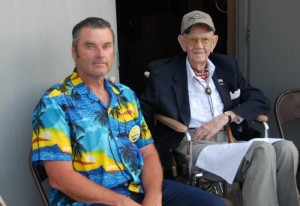
George Perks documented the two-day grand opening of the Bird Aviation Museum and Invention Center, taking more than 1,000 pictures. He took time out from behind the camera to visit with the legends in attendance, such as Tex Hill.
By Chris Perks
During the grand opening of the Bird Aviation Museum and Invention Center, George Perks didn’t just enjoy the historic occasion. He documented the two-day extravaganza, taking more than 1,000 pictures.
Perks was born in Sandpoint, Idaho, on Oct. 23, 1947, to Floyd and Eunice Perks. He discovered an interest in photography early in life. At 10, he developed his own black and white photos in his grandmother’s root cellar.
After graduation from Sandpoint High School, he attended the University of Idaho for a short time, but his dislike of classroom-type studies and his need to be physically active and work with his hands led him in other directions. In 1968, he was accepted at the Marine Engineers School in Baltimore, Md. After graduating with honors in 1970 with an unlimited steam and diesel engineer’s license, he married Kathleen Houseman.
The couple lived in Seattle. Perks was unable to get an assignment to a ship due to a dockworkers’ strike. In 1971, Pacific Power hired Perks to work at the 1400 MW coal-fired power plant under construction in Centralia, Wash.
Perks had always been interested in flying and had taken his first lesson in a Cessna 150, from Ted Farmin, before leaving Sandpoint in 1968. While working in Centralia, he completed the requirements and earned his private pilot’s license. Shortly thereafter, he purchased a Cessna 150 and started building his flight hours. Photography and flying merged as he began taking aerial photos of homes and ranches around the area.
The Cessna 150 soon gave way to a 172. Perks was in the right place at the right time in 1980, when nearby Mt. Saint Helens blew. His aerial shots the day of the eruption and in the following weeks helped document the extent of the devastation and were published in newspapers and magazines.
During the time he worked at Centralia, Perks upgraded his pilot’s license, including commercial and instrument. After he left Pacific Power and the steam power plant, in 1975, he began working for Graystone Corporation as plant superintendent at the Applegate Dam construction site near Medford, Ore. His new flight ratings came in handy on the weekly commute in the 172 to Centralia in the unpredictable weather of coastal Oregon and Washington.
In 1981, Washington Water Power in Spokane contacted him, asking if he’d be interested in the position of plant superintendent at a new, innovative, wood-fired power plant planned for construction in Kettle Falls, Wash. After some minor discussion, the Perks packed up their new son Brian and the 172 and headed to Colville, Wash., near the new plant.
With his expertise from Pacific Power and with input from other members of the team at Kettle Falls, the plant was up and running ahead of schedule and under budget. It was also capable of producing more power more efficiently than the original design specified. During the construction phase, Perks’ aerial and on-site photos were used to update upper level management at progress meetings. His piloting and photography skills were soon being used in other areas of the company to document various projects.
In 1988, when Perks was transferred to the main office, the family, which now included 5-year-old Steven, moved to Spokane. Perks became head of thermal projects, which included interaction with the plant in Centralia in which WWP held an interest. His flying and photography continued for WWP; he often flew executives when the company jet wasn’t required. His photos graced boardroom walls and were often used in reports and annual financial statements.
In 1963, Dr. Forrest Bird purchased property across Lake Pend Orielle from the Perks’ family lake house. With float planes and PBY Catalinas taking off on the other side of the bay, it wasn’t long before Perks made his presence known and a lasting friendship developed. Bird purchased property once homesteaded by Perks’ grandparents; the runway for Bird Air Lodge now bisects what was once pasture.
In 1985, the 172 was sold due to logistical problems at the airport in Colville. Perks was without wings, except occasional flights for WWP employees and business trips in rented aircraft. In the summer of 2003, he was back in the air again with the purchase of another 172. Serious hangar flying soon began in the hangars at Felts Field in Spokane. Friendships began developing with owners of T-6s, Pitts Specials, Stearmans, a Citrabria and various other airplanes. The other pilots soon became aware of Perks’ photography skills, and he gained lots of practice doing air-to-air shots as hanger walls were soon decorated with beautiful photos of aircraft.
Perks retired from WWP on July 1, 2007. He and Kathy are now able to spend more unrestricted time doing two of their favorite things, flying and photography. His digital cameras enable him to get shots that were out of his reach just a few years ago. Now with Perks retired, who knows what he and Dr. Bird will be up to; they each know that they have a ready copilot!













